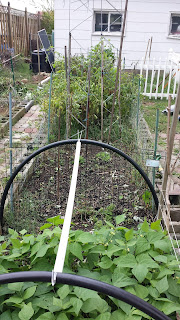



The above pictures represent what I would describe as the best of the day we spent at Monticello. Going clockwise, there is the screenshot of the official banner that was displayed on all the monitors in the various seminar tents, me beside the statue of Thomas Jefferson, the tent where the soil renaissance seminar was held, the various tents on the main grounds where the vendors were set up, a picture of the early morning fog hanging in the valley beside the Jefferson garden and me with Robert Hatch - the man who brought the garden back and who has written several books on Jefferson's revolutionary garden.
As I said in my earlier post, I am quite pleased that I am doing the best I can for my soil. For, if your soil is good, it solves a lot of issues for your garden. But more importantly, it was nice to be with people who shared a common interest and but had different perspectives. Here I am, in the red shirt, sitting with the various people who were attending the soil renaissance seminar. It was quite satisfying indeed.
I also attended a seminar on winter gardening during the day. I have toyed with the idea of growing vegetables in winter to be able to extend the growing season. And, as I listened to the back and forth about the various techniques and structures that could/should be used, I slowly came to realization that maybe this just wasn't what I wanted to be doing after all.
The discussion began about what plants could be grown over the winter. That list was, to no surprise to me, very limited. We first established that it was basically root crops and hardy plants like cabbage, kale, broccoli and a few others that could be successfully grown through winter. They then explained the need for covering the plants with the spun fiber directly over the bed and then the need to build a support structure once the plants began to grow. So far, not too bad. But then, we began talking about bigger structures, blankets, and even greenhouse plastic and the need to build heavier duty structures of various types. This is where I began to think that this was a lot of effort for what they termed as small output crops. I mean, in all honesty, in my mind it would be much easier to buy my carrots from the grocery store than to put all this effort to get them fresh from my garden once I shoveled them out and uncovered them. Exaggeration I know but not too far off the point.
So, this seminar was beneficial in that it confirmed what I learned from trial and error here and there over my time as a gardener. I can understand a commercial or CSA grower doing this - it's their livelihood. But for the backyard gardener, unless you are in the south and can avoid the structures, I don't see the payoff.
We spent the rest our time at Monticello wandering through the various exhibitors tents and the grounds. As we were meandering around the Jefferson garden, I recognized Peter Hatch. He has written several books regarding Jefferson and the revolutionary garden. I own 'Thomas Jefferson's Garden Book" and will have to buy 'A rich Spot of Earth: Thomas Jefferson's Revolutionary Garden at Monticello'. I introduced myself and asked him for a picture which he graciously approved.
All in all, the day was fun for me. My wife, on the other hand, had her moments but was mostly there to spend time with me as we wandered the grounds. I would recommend Monticello to any one who is fascinated with gardening and also, the history of our country. There is much to see on a normal tour and it is very beautiful there.














